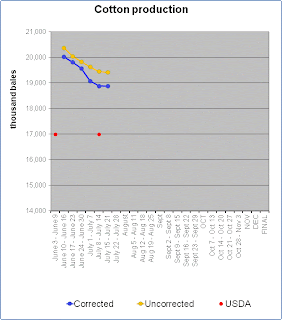Corn Yield: 139.4 bu/ac
Corn Production: 11,983 million bushels
Soybean Yield: 36.4 bu/ac
Soybean Production: 2,712 million bushels
Cotton Yield: 804 lbs/ac
Cotton Production 18.551 million bales
Production is falling faster than yields. Corn yields were down (only!) 0.4% this week while production fell 1.2%. This is of course due to abandonment as another 661,200 acres dropped out of harvest. As the worst acres drop out of harvest, this actually supports the crop yields taking the worst land out of the calculation. This is particularly true for cotton. For soybeans, the harvesting rate is much less sensitive to condition so the harvested area change is far smaller.
I suspect I'm high on corn yields, harvesting rates and therefor production. The trade estimates are a good 7 bu/ac lower than I am now and probably a million acres + lower on harvesting rates. Harvesting rates in the US appear to have been rising over time, so it is hard to tell if we will see the 86% harvesting rates seen in 1988 and 1993. If so, that would put us at about 83 million acres harvested. But one might argue that ''normal'' harvesting rates have risen by as much as a couple percent over the last few decades. Right now I'm running an 89% harvesting rate, which I suspect is too high. If one takes an 87% harvesting rate with a trade estimate 132 bu/ac you could shave another 900 million bushels off my estimate, putting the crop right at 11 billion bushels.
Soybean yields continue to fall with Iowa conditions making dramatic changes. I don't know if I should believe those numbers as I suspect I'm well below trade estimates on beans now, perhaps as much as 2 bu/ac with the crop contracting faster than corn over the last two weeks.
For cotton, I'm not sure what to comment on this other than the experts got together recently and pegged the crop at about 16.5 million bales. Who am I to argue with the likes of Carl Anderson and O.A. Cleveland? I think once again, the model doesn't handle the trade offs between yields and conditions in a place like Texas very well. I'm a good 2 million bales above the experts at the moment.
Corn Production: 11,983 million bushels
Soybean Yield: 36.4 bu/ac
Soybean Production: 2,712 million bushels
Cotton Yield: 804 lbs/ac
Cotton Production 18.551 million bales
Production is falling faster than yields. Corn yields were down (only!) 0.4% this week while production fell 1.2%. This is of course due to abandonment as another 661,200 acres dropped out of harvest. As the worst acres drop out of harvest, this actually supports the crop yields taking the worst land out of the calculation. This is particularly true for cotton. For soybeans, the harvesting rate is much less sensitive to condition so the harvested area change is far smaller.
I suspect I'm high on corn yields, harvesting rates and therefor production. The trade estimates are a good 7 bu/ac lower than I am now and probably a million acres + lower on harvesting rates. Harvesting rates in the US appear to have been rising over time, so it is hard to tell if we will see the 86% harvesting rates seen in 1988 and 1993. If so, that would put us at about 83 million acres harvested. But one might argue that ''normal'' harvesting rates have risen by as much as a couple percent over the last few decades. Right now I'm running an 89% harvesting rate, which I suspect is too high. If one takes an 87% harvesting rate with a trade estimate 132 bu/ac you could shave another 900 million bushels off my estimate, putting the crop right at 11 billion bushels.
Soybean yields continue to fall with Iowa conditions making dramatic changes. I don't know if I should believe those numbers as I suspect I'm well below trade estimates on beans now, perhaps as much as 2 bu/ac with the crop contracting faster than corn over the last two weeks.
For cotton, I'm not sure what to comment on this other than the experts got together recently and pegged the crop at about 16.5 million bales. Who am I to argue with the likes of Carl Anderson and O.A. Cleveland? I think once again, the model doesn't handle the trade offs between yields and conditions in a place like Texas very well. I'm a good 2 million bales above the experts at the moment.














































